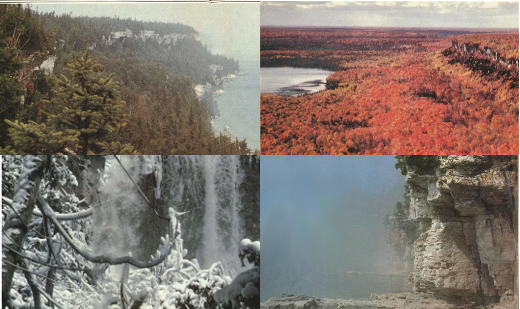
From Queenston on the Niagara River to Tobermory on the tip of the Bruce Peninsula, Ontario is blessed with the Niagara Escarpment. Rob, Cecil and Ron tell stories about the struggles to protect the Escarpment from development.
The Niagara Escarpment, a 450 million-year formation that dominates the landscape in the most populated and densely developed part of Canada.
It’s a much-loved wonderland — a UNESCO World Biosphere Reserve with abundant forests, farms, wetlands, recreation areas, hiking trails (including the Bruce Trail), historic sites, scenic villages and towns. The Escarpment’s rich ecosystems support 300 bird species, 53 mammals, 36 reptiles and amphibians, 90 fish and 100 varieties of special interest plant life, including 37 types of wild orchids.
The Escarpment area is, rich with dolostone, sand, and gravel - the perfect material to quarry for building roads and for construction. In the early 1960s, as southern Ontario was growing, developers and aggregate operators targeted the Escarpment as an ideal source of building material. Meanwhile, Escarpment area farmland was becoming a magnet for residential subdivision development.
As these problems escalated, citizens, the provincial government and environmental groups became concerned. Three people caught up in the early struggles to preserve the Niagara Escarpment were Cecil Louis, who was working for the Ontario government as a planner at the Ministry of Municipal Affairs and Housing, Ron Reid, a naturalist on the staff of the Federation of Ontario Naturalists (FON) and Rob Leverty who became the Executive Director of the Coalition on the Niagara Escarpment (CONE), an organization formed by the FON and other concerned environmentalists to protect the Escarpment.
The Political Situation in the 1960s and 70s
The Ontario government in the 1960s and 1970s (like all Ontario governments since), was seeking to balance explosive growth in southern Ontario with the need to protect and preserve green space, and the Niagara Escarpment was top of mind. In 1967, then-Premier John Robarts commissioned Len Gertler from the University of Waterloo to write a report with recommendations on how to protect the Escarpment.
Gertler took an unusual, almost revolutionary approach to planning for the Escarpment. His report came out before environmentalism and ecosystems were household words, yet it recommended protecting large parts of the Escarpment from development, with decisions to be made by an appointed group.
This represented new thinking on two levels. Up to the late 1960s land use planning was left largely to local governments, which tended to favour development to expand their tax bases. Gertler called for regional planning that looked at what would be best for the whole province. He implied in his report that a feature like the Niagara Escarpment clearly transcended municipal boundaries, thus requiring provincial level planning.
The other element of the new thinking was that the Escarpment should be protected because of its beautiful landscapes. Until then, it was not customary for governments to attach too much value to natural beauty, other than creating an occasional new park.
In 1973, the Ontario government, headed by William Davis, who succeeded John Robarts as premier, moved forward with adopting the planning report by passing legislation to protect the Niagara Escarpment – the Niagara Escarpment Planning and Development Act (“the Act”). Premier Davis also set up the 17-member Niagara Escarpment Commission to prepare a Niagara Escarpment Plan, and to decide what development would be allowed in the area.
After the Act was passed, the battle to protect the Escarpment began in earnest, and it was long and intense. Developers, aggregate companies, landowners and some municipal governments were up in arms over the restrictions that were put in place under the Act, so they lobbied hard to soften those restrictions as much as possible. This battle lasted over many years, and became one of the biggest public struggles over the environment that ever took place in Ontario. It was constantly in the media and was mentioned all around Ontario.
Post-Niagara Escarpment Act
The opposition caused by the passing of the Act led to a counter protest by environmentalists at Queen’s Park in 1978, followed by the formation of the CONE. Its matriarch was Lyn MacMillan, and other members included Ron Reid, along with the Canadian Environmental Law Association, the Canadian Nature Federation, Pollution Probe and the citizen-led Foundation for Aggregate Studies.
CONE’s first test was to fight the construction of a proposed executive retreat to be built at the Forks of the Credit River on the Escarpment. MacMillan deployed her extensive network of contacts to arrange a meeting with then-Premier Davis. The goal was to persuade him to boost the funding available to buy up ecologically sensitive areas so they could be protected.
Premier Davis finally committed $25 million to land protection. .
Over the years (before and after the Act became law), all three parties in the Ontario Legislature have officially supported the Escarpment legislation and protection policies The late NDP MPP Mel Swart was particularly supportive of the Escarpment. Other supportive Members of the Ontario Legislative Assembly were Conservative MPP Norm Sterling, Liberal MPP Jim Bradley and NDP MPP Ruth Grier. Sterling, Bradley and Grier also served as Ministers responsible for the Niagara Escarpment Plan.
The Niagara Escarpment Today
Under the Act, the Niagara Escarpment Plan was approved by Cabinet in 1985, setting out detailed land use policies l. It was t updated in 1990 and again in1995, as required by the Act. The next review will take place in 2015.
Today, developers and aggregate companies remain aggressive in their efforts to gain approval for projects in the Niagara Escarpment. It is the job of the Niagara Escarpment Commission to review every application. The Commission typically receives about 550 permit applications each year; it approves about 90 per cent of these, after ensuring that the proposals are in conformity with the policies of the plan, that are designed to keep the Escarpment protected.
The result today is a remarkable, environmentally protected area within easy reach of millions of Ontarians and visitors. Every year, some 400,000 visitors come to the Escarpment, thanks to the foresight of the Ontario provincial government, and the consistent support of the many members of the general public acting as part of, or in concert with, Coalition on the Niagara Escarpment.